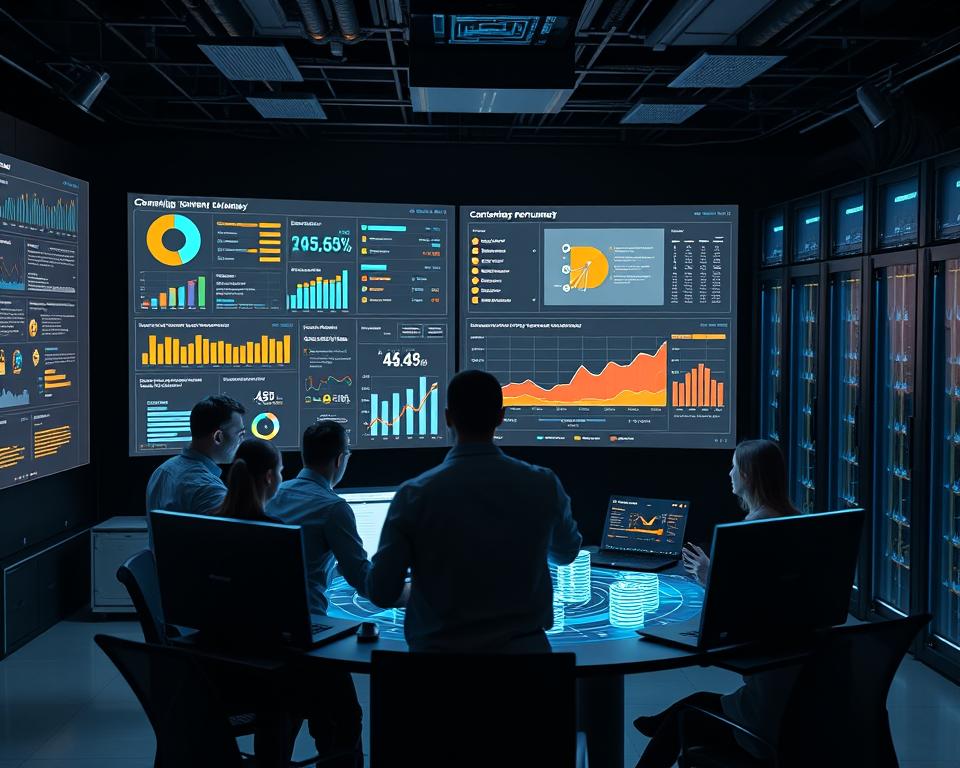Specialist Digital Marketing 1on1 SEO by Marketing1on1
Are you informed that 90% of internet interactions start with a search engine? Standing out among search outcomes isn’t just beneficial—it’s crucial. This is when Marketing1on1 intervenes. Since 2010, this New York-based firm empowered smaller enterprises enhance its online presence through personalized strategies.
In contrast to generic agencies, Marketing1on1 employs a hands-on method. Their own local SEO Columbus education system blends skilled direction alongside immediate modifications. Clients enjoy results—like increased twofold organic traffic—minus prolonged agreements. A clear interface makes progress apparent throughout the process.
Their analytical techniques evolve to trends, securing lasting achievement. Be it starting your SEO strategy or enhancing it, they deliver quantifiable improvement. Without speculation, just proven techniques.
Significant Points
- Marketing1on1 has over a decade of experience boosting organic rankings.
- Their custom strategies focus on real, quantifiable outcomes.
- Customers appreciate versatile, contract-free offerings featuring absolute clarity.
- A scientific approach sets them apart from generic agencies.
- Their dashboard monitors development, ensuring responsibility.
Defining Digital Marketing 1on1 SEO
Conventional strategies seldom succeed in the modern market. Standing out demands a plan designed for your business goals—not a template. That’s the core of personalized SEO mentoring: tailor-made strategies which evolve with your progress.
The Personalized Approach to SEO
Rather than off-the-shelf fixes, experts examine your website’s framework along with content voids. Regular assessments track progress with exclusive instruments. Such a cyclical method blends technical fixes with content optimized for people to create enduring effects.
Bruce Jones, a seasoned SEO expert with 20 years in the field, conducts meetings with actionable homework. Users enact improvements right away, accelerating results. Testimonials highlight how his hands-on method turns theory into measurable growth.
Divergence from Standard SEO Practices
Most agencies offer inflexible plans. One-on-one coaching adjusts every strategy—ranging from keyword discovery to link building—to your audience. Traditional methods often ignore unique challenges, like local competition or niche markets.
The key distinction is: while others guess, this approach relies on data. Tailor-made interfaces show real-time rankings and traffic shifts. No contracts mean flexibility, and transparency ensures you’re never in the dark.
Why Small Businesses Need Digital Marketing 1on1 SEO
Local companies commonly face difficulties in getting noticed against bigger competitors. Limited budgets and resources render it difficult to gain visibility online. Tailored strategies can bridge this gap, transforming community standing into a market advantage.
Competing with Larger Companies
Corporate brands control search results with massive ad spend. Yet intelligent strategies including community directories and focused keywords enable small firms to establish their niche. An analysis revealed a 150% return on investment within half a year by focusing on hyper-targeted audiences.
Affordable Methods for Expansion
Standard agency retainers deplete budgets through inflexible agreements. Flexible, pay-as-you-go models remove intermediary costs. Optimizing your Google Business Profile alone may enhance community footfall—with minimal spending.
-
Economical: No upfront costs, pay solely based on proven outcomes.
-
Regional targeting: Beat major brands in local searches.
-
Openness: Instant dashboards reveal progress without assumptions.
Fundamental SEO Techniques for Enhanced Rankings
Elevating online standings demands a blend of systematic accuracy and innovative methods. Below are proven methods designed to increase exposure and pull in focused traffic.

Keyword Research for Targeted Traffic
Begin with keyword segmentation—an approach that organizes analogous keywords. Tools like Ahrefs identify terms with substantial searches and low rivalry. For example, a bakery might target “gluten-free cupcakes near me” rather than standard dessert descriptors.
-
Group topics: Sort terms according to their objective (e.g., “buy” vs. “learn”).
-
Regionalize: Incorporate area-specific terms to target local audiences.
-
Monitor patterns: Update terms quarterly for ongoing relevance.
In-Page SEO Methods
Header tags and meta details need polish. For instance, a page titled “Best Running Shoes” gained 40% more clicks upon being reworked to “Top Cushioned Running Shoes for Marathon Training 2024.”
Further optimizations involve:
- Header tags (H2, H3) that mirror search queries.
- Embedded links facilitating navigation for both users and search engines.
- Picture descriptions enriched with relevant terms.
Establishing Authoritative Backlinks
Quality backlinks sourced from trusted websites indicate credibility. A tech blog earned links by publishing expert roundups with industry leaders. The emphasis is on contextual relevance rather than sheer numbers.
Prioritize:
- Invited content on focused blogs.
- Broken link building (replacing dead links with your content).
- Joint ventures with community companies to foster reciprocal links.
Content Enhancement for Measurable Results
Exceptional content transcends mere verbiage—it relies on a tactical approach. An optimal mix of reader-friendly language and technical accuracy keeps audiences engaged while satisfying search engines. Marketing1on1 creates content optimized for search without compromising your brand’s personality.
Developing SEO-Optimized Content
Content optimization starts with structure. A fitness client’s blog saw a 30% traffic boost after reshaping articles with:
-
Easily readable titles: H2s like “5 Protein Shake Recipes for Post-Workout Recovery” match search intent.
-
Seamless keyword integration: Keywords like “organic protein powder” are embedded fluidly in beginnings and sections without stuffing.
-
Latent Semantic Indexing (LSI): Related terms (e.g., “muscle recovery,” “vegan protein”) signal topic depth to algorithms.
Balancing Readability and Keyword Density
Applications such as Hemingway Editor maintain textual clarity, one bakery enhanced its conversion rate by 20% following sentence simplification and bullet integration.
Key recommendations involve:
-
Optimal word count: 1,200–1,500 words for competitive niches, 800–1,000 for local services.
-
Updating outdated content: A tech blog updated 10 outdated guides, lifting rankings by 15% in 60 days.
-
Clarity ratings: Target a Flesch-Kincaid score corresponding to Grade 8–9 for maximum accessibility.
How Technical SEO Fuels Your Achievement
The backbone of every successful website is its technical integrity. Search engines prioritize sites that load quickly, display properly on all devices, and use structured data effectively. Ignoring these elements may render your site unseen, no matter how well it’s written.
Website Performance and Mobile Adaptation
Slow-loading pages frustrate users and hurt rankings. An analysis demonstrated a 40% decrease in bounce rates once Core Web Vitals were enhanced. Critical actions involve:
-
Evaluate site speed: Use tools like PageSpeed Insights to identify bottlenecks.
-
Assess mobile design: Verify that navigation elements and text resize properly on mobile devices.
-
Reduce image file sizes: Shrink image sizes while preserving clarity.
Data Structuring with Schema Markup
Organized data enables search engines to parse your material better. Implementing product schema may showcase pricing and feedback in search outcomes. Optimal techniques:
- Implement JSON-LD markup for key pages (e.g., events, recipes).
- Use XML sitemaps to guide crawlers on large sites.
- Update schema quarterly to align with search engine guidelines.
Maximizing Local SEO for Neighborhood Engagement
If local users are looking for services, your company ought to appear first. *Local SEO* ensures you appear in the “(near me)” results that drive foot traffic. Marketing1on1’s New York clients consistently rank in the top 3 local pack listings—proof that hyper-targeted strategies work.
Start by claiming and optimizing your *Google Business Profile*. Regularity matters—verify that your business name, address, and phone number (NAP) remain consistent on every platform. A bakery client doubled its visibility by fixing mismatched listings on Yelp and TripAdvisor.
Customer feedback fosters credibility and improves rankings. Motivate satisfied clients to post reviews on your profile. A restaurant enjoyed a 300% boost in physical traffic after implementing a review drive with subsequent emails.
Target *geo-modified keywords* like “emergency plumber in Austin” or “vegan catering Boston”—terms that draw in immediate local consumers. Combine these with *community content hubs*—articles like “Best Parks in Dallas for Family Picnics” enhance local SEO signals.
Neighborhood citations and localized landing pages augment *community engagement*. A roofing business increased inquiries through localized page creation. All elements, spanning from schema implementation to mobile optimization, secure your top local standing.
Reasons to Select Marketing1on1 for Your SEO Adventure
Achieving top rankings demands more than chance—it requires established proficiency. Boasting over 15 years in the field, Marketing1on1 has supported enterprises in succeeding despite search engine changes. They merge profound insights with unwavering transparency, so that customers witness tangible advancements.
Decades of Industry Experience
From 2010 onward, Marketing1on1 has evolved with each significant search algorithm change. Customers gain from insights acquired across sectors ranging from neighborhood bakeries to technology startups. Their client loyalty exceeds industry standards by 35%, demonstrating enduring performance.
Key milestones include:
- Mastering Google’s Panda and Penguin updates to protect client rankings.
- Pioneering mobile-first strategies before they became standard.
- Implementing ultra-local strategies for neighborhood enterprises.
Transparent, Contract-Free Services
Absence of extended agreements provides agility. Clients pay only for measurable outcomes, accompanied by lucid dashboards monitoring all key figures. A roofing business optimized keywords in real time, resulting in a 50% lead surge within three months.
Your search journey deserves a partner who prioritizes your growth—not rigid templates. With expertise and openness, Marketing1on1 turns challenges into victories.
Marketing1on1’s Unique 1on1 Training Model
Where many coaching programs complicate instead of clarify—discover an alternative. In contrast to canned lessons, Marketing1on1’s 1on1 seo training connects you with specialists to tackle problems on the spot. Each session is customized for *your* site requirements, turning theory into measurable growth.
Hands-On Learning with Experts
Led by Bruce Jones, a two-decade SEO expert, sessions are oriented around *your* obstacles. Weekly meetings include screen-sharing to troubleshoot issues live. Customers applaud the straightforwardness—eschewing buzzwords for practical solutions.
Notable elements are:
-
Tailored skill audits: Identify gaps before crafting your plan.
-
Qualification scheme: Gain certifications through the acquisition of essential skills.
-
Performance monitoring: Track progress with shared goal-setting docs.
Practical Assignments with Quick Results
Eschew trivial tasks—projects such as refining title tags or reviewing backlinks yield prompt enhancements. One client implemented the provided on-page guidelines and experienced a 25% increase in traffic within 14 days.
Instances involve:
- Geographic keyword allocation for location-specific pages.
- Reports on broken links to secure rapid improvements.
- Regular content update timetables.
This approach abandons passive lectures in favor of collaborative, hands-on effort. When education converts into improved search positions, all parties benefit.
Tangible Success Stories from Marketing1on1
Seeing is believing—here’s how businesses transformed their online presence. From e-commerce stores to local services, the *results* speak for themselves. Review a *case study* and genuine *testimonials* showcasing quantifiable progress.
Example: Organic Traffic Doubled
A central U.S. online retailer faced low exposure. Once precise keyword grouping and technical corrections were applied, their *traffic* leaped by 212% over six months. Critical improvements comprised:
- Enhanced product listings using location-based keywords.
- High-quality links from specialized blogs.
- Monthly content refreshes to maintain rankings.
Client Praise and Success Feedback
Julia Lamb, a boutique owner, shared: “Their guidance turned our site into a lead-generating machine—97% more inquiries in 90 days.” Rosemary Hood, a restaurateur, added: “Finally, a team that delivers on promises. Our foot traffic tripled after local SEO tweaks.”
Comparative analytics clearly show a steady rise in metrics. Customers gain additional advantages through a referral system that incentivizes collaborative growth. Authentic methods, genuine *outcomes*—nothing superficial.
Begin Your SEO Adventure Now
The first step to better rankings is understanding where you stand right now. An initial *audit*, offered free, identifies issues—ranging from delayed load times to absent keywords—for prompt remediation. Subsequently, a defined *plan* directs actions with clarity and trackability.
Evaluating Your SEO Status
Begin with a site *audit* to spot technical issues. Software like Screaming Frog helps locate malfunctioning links and replication issues. Next, review competitors to identify gaps in your content or backlinks.
Important measures involve:
-
Kickoff checklist: Track progress from day one.
-
Market comparison: Examine successful tactics in your sector.
-
Quick wins: Address on-page elements like meta tags and alt texts initially.
Establishing Achievable Growth Objectives
Reject ambiguous goals like “gain more visitors”—opt for measurable objectives like “boost organic visits by 20% within 3 months”. Utilize the SMART method to maintain focus and accountability.
Prioritize tasks with a matrix:
-
Short-term: Optimize 10 product pages this month.
-
Long-term: Establish 5 authoritative links every quarter.
-
Integration: Merge your SEO with email and social outreach initiatives.
When equipped with a roadmap and effective tools, your *SEO initiation* shifts from conjecture to progress.
Frequent SEO Pitfalls to Steer Clear Of
Tiny errors may undermine your SEO efforts—here’s how to fix them. Several enterprises unconsciously impair their SEO with *mobile usability* shortcomings or mismatched business data. Marketing1on1 detects such problems promptly, converting flaws into strengths.
Neglecting Mobile Responsiveness
Due to Google’s *mobile-first approach*, your website needs to perform impeccably on mobile devices. Delayed responses or cluttered designs irritate users and can result in SEO setbacks. A case study showed a 40% bounce rate drop after fixing:
-
Fluid design: Verify interface elements across various devices.
-
Core Web Vitals: Improve measurements such as LCP.
-
Optimizing image files: Reduce file sizes without losing clarity.
Neglecting Local Directory Consistency
Irregular *local listings* baffle search algorithms. One plumbing service experienced a 50% reduction in inquiries due to inconsistent address information. Marketing1on1’s review procedure includes:
-
NAP consistency: Verify that your NAP details remain consistent on each directory.
-
Elimination of redundancies: Unify or delete redundant entries.
-
Review management: Motivate reviews to enhance credibility.
Further mistakes cover *keyword cannibalization* (internal competition) along with sparse text. Periodic assessments maintain a refined strategy—transforming uncertainty into development.
The Future of SEO and Digital Marketing
The landscape of search is evolving faster than ever before. Remaining ahead means preparing for shifts ranging from *algorithm updates* to new technologies.
Adapting to Algorithm Changes
Google’s *AI-powered search* now prioritizes natural language and user intent. Standards like E-E-A-T give preference to detailed, reliable material. Here’s how to adapt:
-
Prioritize experience and trust signals: Showcase credentials and user reviews.
-
Optimize for zero-click searches: Craft succinct responses aimed at zero-click outcomes.
-
Track Major Algorithm Changes: Revise your approach as metrics change.
Emerging Trends in 2024
Both video and voice search are altering the way users access data. Implementing a *video SEO* approach, for instance by refining YouTube tags and descriptions, may secure up to 50% additional visitors. Further emerging patterns:
-
Enhancing for Voice Queries: Concentrate on colloquial search terms (such as “best Italian restaurant near me”).
-
Interactive content: Quizzes and polls boost engagement and dwell time.
-
Community-Centric Indexing: Localized material beats broad, generic pages.
Staying ahead means embracing these shifts—not reacting to them. With the right partner, your strategy evolves as search does.
Marketing1on1’s Affordable SEO Services
Economical services deliver potent capabilities accessible to small enterprises. Unlike agencies with bloated pricing, our model offers straightforward benefits without extra charges. Each investment is dedicated to achieving tangible improvements.
Custom Packages for Every Need
Universal solutions seldom succeed. Our layered *service options* conform to your objectives and financial plan. For example:
-
Entry Package: Ideal for community companies requiring fundamental improvements.
-
Intermediate Level: Includes advanced backlinks and content clusters.
-
Enterprise Tier: Comprehensive strategies for competitive industries.
Need flexibility? Supplement with individual services such as contributed articles or site evaluations. Users value the freedom—spend only on essentials.
Clear Pricing with No Unexpected Charges
Concealed charges undermine credibility. We employ fixed pricing with complete upfront disclosure. One customer reduced expenses by 30% after opting for our on-demand plan over a retainer.
Major advantages are:
-
Transparent contracts: No ambiguous language or automatic renewals.
-
Periodic assessments: Refine offerings in response to performance.
-
Kickoff roadmap: Track progress from day one.
Affordable shouldn’t mean cut-rate. Our direct approach means you receive professional assistance minus extra costs.
Building Your Online Reputation with SEO
Your online *reputation* shapes customer decisions before they even visit your site. SERPs provide initial judgments—favorable *reviews* and precise listings foster *trust*, whereas discrepancies spark doubts.
Kick off with a *review-building plan*. Prompt satisfied clients to post reviews on Google and specialized sites. One bakery increased its exposure by 40% through review calls-to-action on receipts and subsequent emails.
Track your *brand’s online footprint* using tools such as Google Alerts for monitoring mentions. So you can rectify inaccuracies promptly. A tech enterprise amended a misleading product assertion early to maintain its credibility.
Credible references such as Wikipedia or official press statements confer authenticity. A case study showed a 25% traffic increase after securing a Wikipedia citation with proper sourcing. Press releases distributed through reputable wires further amplify your message.
Effective crisis response strategies are key. If negative content ranks, counter it with fresh, optimized updates. A customer mitigated a negative blog entry through professional counterarguments and supportive testimonials.
Each digital encounter molds your online image. Through active SEO management, you steer the story—cultivating *trust* with every result.
Tracking Your SEO Achievements
Effective strategies stem from proper measurement of key indicators. Neglecting proper analytics may cause even excellent tactics to falter. Instant analytics transform raw numbers into concrete actions.
Observing Search Term Standings
The control panel displays daily changes in search rankings. Focus on high-intent terms that drive traffic. For example, a plumbing company might track “24-hour emergency plumber near me” instead of generic phrases.
Recommended techniques comprise:
-
Regular ranking reviews: Spot trends before competitors do.
-
Group keywords by intent: Segment queries into informative and buying categories.
-
Refine strategies according to click-through rates: Should click rates drop, improve your descriptions.
Analyzing Traffic and Conversions
Relying solely on organic visits does not ensure achievement. Consider conversions—including inquiry submissions or call volumes—to measure your investment’s payoff. A 20% bounce rate drop might signal better content alignment.
Critical data points to track consist of:
-
Attribution models: See which pages drive the most leads.
-
Dwell time: Extended visit durations generally indicate better engagement.
-
Increase in quality backlinks: Quality links boost domain authority.
Establishing clear goals helps pinpoint successes and opportunities for betterment.
Conclusion
Your search for lasting online growth ends here. Marketing1on1 melds profound knowledge with clear openness to produce genuine outcomes customized for you. Whether establishing regional leadership or national recognition, their approaches evolve with your progress.
Key advantages include:
- Tested methods resilient to search engine updates.
- Adaptable, no-contract services aimed at return on investment.
- Live dashboards tracking every milestone.
Eager to elevate your online performance? Claim your free audit today and see where opportunities lie. Award-winning support ensures you’re never alone on this journey.
With measurable wins and ongoing guidance, success isn’t just possible—it’s guaranteed.










